No Mow
A guy who raised an orphaned beaver kit once reported that at a certain age the animal started dragging brooms and clothes and whatever else she could find to make little dams in every doorway of the cabin. You probably smiled as you read that and thought: what simple little robots. But think about it a little longer and the behavior might become uncomfortably recognizable. We humans are beaver-like, drawn by a similar unconscious, primordial desire to remake our ecosystems. Even us ecologically sensitive types are doers to a fault — we wake and immediately start cultivating and tending and building. Simple little robots with big brains that justify myopic internal cues.
The No Mow May movement encourages people to help wildlife – specifically pollinators – by letting their lawn grass grow. Our beaver-like human need to do is going to make it hard for the movement to catch on. But if you can get over that, what a pleasure it is to see blue and white violets appear, then yellow dandelions and pink fleabane and purple creeping Johnny and yellow wild strawberries and orange hawkweed and white and red clovers. Right now someone is calculating the economics and time it would take to rip up their grass and plant a pollinator garden, but there is already a pollinator garden within the grass just waiting to be let out. And the grass itself is stunning when it’s tall: the delicate panicles on the bluegrass and fescues, the thin colored spikelets on the foxtail and brome. You can watch the wind in this grass. Watch the insects hatch from it, drawing flycatching songbirds and endangered bats.
As fate would have it, the lawn I let grow out this year abuts a food plot I planted for wildlife two years back in a fallow strip before the woods. I spent hours resurrecting an old plow and a set of disks from the 1940s that I used to turn the earth. Lime applications preceded buckwheat cover crops that preceded two separate clover seedings (the first didn’t take); money spent on diesel and seed, not to mention big chunks of time. The clover’s fine – wild animals eat it sometimes. But what a lesson as I watched turkeys all spring long walk through the clover and into the overgrown lawn grass to feed and feel safe.
VT Almanac LIVE at the Chandler Center for the Arts
Thank you to Chandler Center for the Arts, Turnip Truck, the vendors, our readers, the attendees, and everyone else who made this a special night. These photos were taken by Brian Carroll.











Bear Bacon
Ken took a fine bear on the second to last day of the season. And as we sat in camp that night and took it in – that mixture of disbelief and gratitude that hunters feel in the wake of success – talk turned to bear bacon.
You’ll find references to bear bacon in the historical record, but in many cases the phrase seems to refer to cured and smoked bear ham (i.e. hindquarter). We wanted to make it with sidemeat – as if the bear were a pig. The 250 pound liveweight was roughly equivalent to the weight at which you might slaughter a hog, but of course the animals are built very differently. Bears are like outside linebackers – well defined musculature designed for strength and speed. Hogs are softer and stouter – like guards or tackles with big bellies designed to push and plug up the line of scrimmage. All of which is to say that you don’t get the width or the marbling on a bear’s bacon like you do on a pig’s, but if you trim right, you’ll still get a tasty mix of fat and lean, which is the point.
I keep a premade basic meat cure in my pantry; the recipe is: 1 pound of kosher salt; 8 ounces granulated maple sugar; 2 ounces pink salt. I rubbed some of this into the bear meat, sealed it, threw it in the fridge. Every few days I turned it to make sure the juices got distributed. Roughly a week and a half later I rinsed the meat, and learned that it was oversalted – I should have only let it go a week. We’ll get to the fix in a minute.
The next step was to cook it. In a perfect world I would have smoked it, but there’s not always time for perfection. So it went in the oven at 200 degrees and I waited for an internal meat temperature of 150, which took about two and a half hours. The big issue with bear is trichinosis – a roundworm parasite that bears carry – so thorough cooking is key. It’s surprisingly hard to learn the actual temperature that kills the parasite. Some sources say 160 degrees. Some say 145 degrees. Hank Shaw, a food writer whom I trust, says 137 degrees for an hour will do it. It’s tough, though, because every iota of meat needs to hit that temp, and there are lot of uncomfortable variables — like is your meat thermometer spot-on accurate?
When it came out of the oven the meat was a lovely burgundy color. I sliced it paper-thin on an old commercial grinder that my friend Joe Herman gave me. Joe’s a retired butcher who taught me how to cut up pigs years ago simply because I asked. So much rural wisdom is passed along this way — in old barns, in inadequate light, through acts of generosity.
As I mentioned, the meat was oversalted. The solution is to soak it in warm water before frying it – in this case, 3-5 minutes did the trick.
The end result is delicious, though without the smoke flavor, it’s more akin to prosciutto than bacon. I wish I had the courage to eat it without flash frying it. There’s a 99 percent chance that the time it spent in the oven killed any trichinella that was in the meat. But I’m getting cautious with age. Plus, when you’re feeding meat to a 4-year-old, you don’t take one percent chances.
Still, even lightly fried, it’s lovely. The fat part is rich and luscious. The beechnut-finished red meat is unlike anything else.
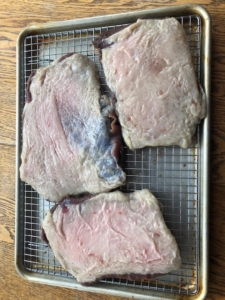 This is how the sides looked when they went into the oven.
This is how the sides looked when they went into the oven.
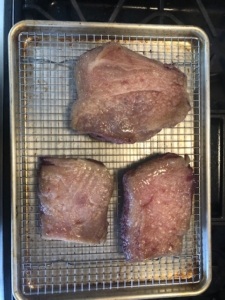 This is how they looked coming out.
This is how they looked coming out.
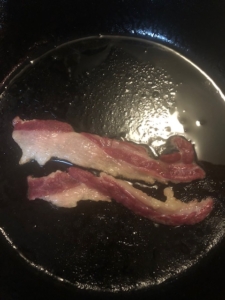 A sample of the finished product crisping up.
A sample of the finished product crisping up.
A Point to Make: We Do Forestry Pretty Well Here
The news is full of the Glasgow climate talks these days, and one of the focal points has been deforestation. It’s a challenge for many of us to put cynicism aside and embrace the breaking news that politicians made a bunch of promises. But the moment calls for us to be better than this.
If you weren’t paying attention, basically what happened was countries, and private companies, pledged $20 billion to “protect forests.” The focus was the tropics, where rainforests are being razed and turned into palm plantations or soy or cattle farms. The Amazon is being cut so heavily that the forest has turned from a carbon sink into a carbon source.
As the media opined about this, one of the themes was hypocrisy and doubt: the west got rich on razing its forests, so is it really realistic, or fair, to expect that $20 billion in aid is going to facilitate/convince a hemisphere to do things differently?
A more positive line of opinion involved the $1.7 billion that is earmarked for Indigenous People and local communities, because there’s good evidence that people who have a vested interest in a place are more apt to manage their forests sustainably.
There’s something to see and consider here. The problem is that when these are the only two lines of thought, it simplifies forest management into us versus them. Wealthy northern hemisphere versus poor southern hemisphere. Pure indigenous cultures versus corrupt and fallen us. But of course, things are much more complicated than that. In this New York Times story, there’s an odd feeling of discovery in the line: “Indigenous communities and others . . . have kept room for animals, plants and their habitats, not by fencing off nature, but by making a small living from it. The key to their success, research shows, is not extracting too much.” The authors point to the Mayan Biosphere Reserve, a 2-million-hectare territory in Guatemala, where local communities manage their forests, selling timber and running tourism agencies. “The forest became a source of livelihood” quotes one observer. “Our goal is to sustain ourselves with a small amount and always take care of the forest,” said one of the natives.
What’s being described here is essentially forest management as it’s practiced in Vermont. The contexts are radically different, for sure. And I don’t want to take anything away from the heroic reality of natives risking their lives to defend a forest from illegal logging – we’re in a privileged position to know nothing of that. The point is simply that the small farmer or woodlot owner in Vermont has more in common with the small farmer and woodlot owner in Guatemala than they do with a terminal harvest in Brazil or even an aggressive clearcut in Quebec. What’s in opposition, where it comes to the health of the planet, is large-scale, industrial, global, profit-driven exploitation versus small-scale, local, conservation-minded, forest management.
This distinction is important because one of the ways we can all do better by the planet is to recognize that we do forestry well in Vermont and support the industry here. Because in a lot of places in the world, they don’t do it well. You know this. There is an opportunity though – and will be again anytime the news cycle is full of stories on forests and climate – to make these points to the masses, because they’re not obvious. The unfortunate take home for many in the wake of this coverage will be that cutting trees in bad, period.
Turning a Patch of Lawn into a Vegetable Garden, Part 5
There’s an old axiom that to be a good builder you need to learn to think like a drop of water. Farming and home gardening can be similarly reduced to: you need to learn to think like a weed. There’s hundreds of years worth of cultivated plant knowledge at our fingertips, and expert growers who can tell us exactly what each garden plant wants and needs. But unless we’re growing in the controlled conditions of a greenhouse, this knowledge is partial at best. Out in the cruel, bare dirt of our short Vermont summer, the art of eliminating competition is where the garden is going to be made or broken.
We’re working on a story for Volume II about all this; talking to professionals about their tricks of the weed-killing trade. But in the meantime I thought I’d share some thoughts from my own garden this year in the hopes that they’re useful to other backyard growers who might be new to this. The plot is 1,800 square feet, and this particular garden is two years old. So far I’ve been able to keep on top of the weeds, and to quote the late Kenny Rogers, knowing when to hold ‘em and when to fold ‘em is probably the biggest reason.
I kept my cards folded all of last year. I broke ground in the spring of 2020, but then cover cropped instead of planting. This plan was based on respect for the established perennial vegetation that was being plowed under, which was going to rise again. It didn’t come to dominate that particular patch of ground by accident. This garden was built on a lawn, so crabgrass was the toughest plant of the bunch. But in a weedy meadow out back, in a different planting I did at the same time, the endemic goldenrods, milkweed, and fern all pushed back in a similar way. Patience was key. Had I tried to grow before the sod had broken down, it would have been a nightmare to fight the crabgrass. By spending a year letting the soil mellow while smothering the weed base, I was able to start the weed fight this year in a position of strength.
This year’s weed control efforts started right away, which is another piece that seems key. If I’d waited until the weeds looked like garden plants, I’d have lost the edge and it would have become real work. The truism here is that if you’ve got a weed-free garden in July, it’s because you put the time in in April and May.
Weeding the 1,800 square feet in this garden probably took a couple hours a week in June, but I’m probably down to an hour a week now that the plants have taken off. I do 20 minutes a morning on my way to the chicken house. I don’t squat unless I absolutely have to, and do 95% of the weeding standing upright with this tool.
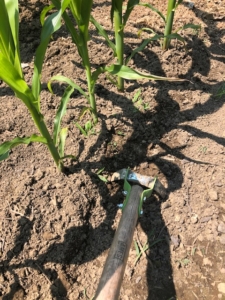
I’ve heard them called a bunch of names, including a loop hoe and a push-pull weeder. It’s basically just a two-sided blade that you can work while pushing or pulling. If you hit the crabgrass when it’s this big:
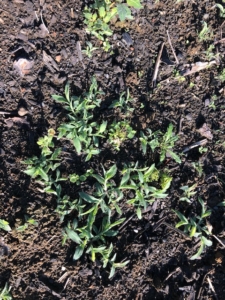
You can kill it with one hand. Those same plants, three weeks from now, would require hand digging.
As I planted, I made sure all the rows were wide enough to accommodate the tool – I use it as a cultivator, too, when the beds are just getting established. I don’t cultivate the paths that are in between the beds deeply – the paths are permanent and I don’t mind soil compaction here. When weeds grow in the paths, I run the loop hoe over lightly so they’re cut near surface level because I don’t want to dig in deeply and aerate the soil and stimulate microbial activity.
Any place in the garden that didn’t get planted this year but might someday got covered. In some beds that meant planting buckwheat or sunflowers, which grow fast and dense – they’re placeholders that bees and birds love. Other areas got covered with old newspapers and then any biomass I had lying around, like old leaves or planer shavings. The point was to eliminate bare dirt as much as possible.
The danger of these kinds of pieces is that the writer can come off as smug – it’s like the way Facebook makes everyone’s life seem more photogenic and perfect than it really is. So let me assure you, this garden has plenty of imperfections. I mulched a bed of peppers with newspaper and planer shavings in late May, and I think I set the plants back at least 2 weeks because the soil temperature couldn’t get warm enough under the mulch. I didn’t look closely at the straw I used last fall to mulch garlic, and the weed seeds in it – weeds I don’t recognize – have been a pain to deal with all summer. That was very much a self-inflicted wound. I could go on.
Still, I’m happy with how things look, and I hope there’s something helpful here for people who are new to all this.
Turning a Patch of Lawn into a Vegetable Garden, Part 4
I’m working on a piece about soil fertility for Volume II of the Almanac, and part of my background research involves reading a book the late Jack Lazor wrote on grain growing. Lazor broke soil fertility down into three interdependent realms: the chemical, the physical, and the biological. And he made the point that conventional agriculture can be exploitive and short sighted when farmers just focus on the chemical. Through Lazor’s organic lens, soil is an ecosystem where billions of microorganisms “work in conjunction with a soil’s mineral and humus factions to feed themselves and the plants that grow there.” High levels of organic matter mean happy microbes and happy plants, and so growers use compost and cover crops and manures to grow soil before they grow plants. In a conventional system, farmers just add chemical nutrients from a bag, and without mitigation measures, the organic matter in this soil is depleted.
Farmers transitioned away from organic practices for financial reasons. And in theory, us home gardeners have the luxury of being able to do better because we don’t have a profit motive. And yet it’s so hard, even for us, to escape the chemical mindset; the allure of magic in a bag as opposed to the hard work of incorporating three yards of compost with a shovel and pitchfork.
I think part of the problem here is that we’ve been conditioned to see fertilization as an act of care. We’re feeding our plants from the bag. And chemical fertilizer works. If you go out and sidedress your plants with some Scott’s 10-10-10 this week, and we get adequate rain, they’re going to pop. Lazor points out that the soil carbon is burned up in the process of converting the fertilizer to Nitrogen, and over time soil is hardened by modern fertilizer. But this is a problem years in the making, as opposed to results that are immediate and easy to see. And if one plant food takes seconds to apply, and the other hours and days, then why not push the easy button?
I think a better way to get through to home gardeners about the benefits of organic amendments is to highlight the way organic soils hold water. In my experience, water retention, not fertility, is the miracle of compost. That’s the reason to do the hard work. For every one percent increase in organic matter, an acre of soil will retain an additional 160,000 gallons of water. And as the climate changes and weather gets more extreme, home gardeners are going to be dealing with dry conditions more and more. It’s easier to get nitrogen from a bag than from compost, but it’s easier to mix in compost once a year than it is to lug a watering can around to every plant all summer.
I laid out this garden with a center hallway, then used a broadfork and hand tiller to elevate beds. (Because this was a lawn that’s been mowed for decades with a riding mower, it’s pretty heavily compacted.) I borrowed a truck trailer and bought 2.8 yards of compost, which I incorporated into the top layer of the beds. That’s all I did to make the beds. I didn’t raise them because I want the plants to be able to work their roots down into the cool reservoir of the earth. As I add compost each year, they will naturally raise themselves.
So far this year it’s been relatively dry. And I’ve done no supplemental watering. Still, the dirt’s inherent 4.6 percent organic content (this figure from the initial soil test) and the compost I added have allowed the plants to take hold and take off.
Trout Fishing
My friend Kris and I met in Mrs. Kevorkian’s kindergarten class, which means I’ve been a bad influence on him for three decades now. When I suffer from panic attacks brought on by the realization that another summer’s slipping through my fingers, I often find myself dialing his phone number. “Wrap it up,” I said on a Friday morning, “we’re blowing off work.” About an hour later we had the rods in the back of his Jeep and were pointed up a wood road, climbing into the hills.
As the jeep bumped and bucked over the washed-out macadam we puffed bug-spray cigars and told fish stories: that Boy Scout trip to a remote Vermont pond that may or may not exist anymore, where as a 10-year-old I hooked an 18-inch brookie on the day’s first cast; a sinkhole in New York’s Beaverkill river where monster browns torpedoed from the depths like sharks.
We parked near a small brook and followed a tannin-stained ribbon of water into a birch glade. You hunt trout in water like this. We stalked on tip toes to the head of each pool and made offerings without casting shadows. More often than not the cagy brook trout would scatter with the rods first motion – quicksilver shapes, there then gone – but a few hits set. When hooked these little trout danced across the surface of the water on lean, wild muscles.
Eventually we hit a chain of beaver ponds and fished them, too. Beaver pond trout fishing is ephemeral. If the water is cold enough, and the conditions are right, these ponds can be jewels. But then overnight, maybe the fishing’s gone. Maybe you get a year out of a pond, maybe two, or five. But maybe the conditions will never be right, or never be right again.
We fished three ponds that day, big expansive wetlands that lay sprawled out on a plateau that was about 2,000 feet above sea level. There was no human sound anywhere. Just the whisper of a light, steady wind. Bird song. The whipping sound of the rod as it cut through the air and the occasional click of a turning reel.
We stood on the dam and cast dry flies onto a tea-colored canvas. Fifteen feet from shore a beaver trolled back and forth, his keen black nose trying to make heads or tails of us. In the middle distance, beyond the pear-shaped contour of the pond, the wind pressed its presence into the lime green saw grass: feathered naps and cowlick whorls; look at the hair on your forearm and see the wind blow through this grass.
Rods bent and lines sheared through the tannin-stained depths. Lines sheared.
I found this old essay in a pile of papers while cleaning my office. It was written in July, 2008. Kris and I both have four-year-old daughters now, and those carefree days of being able to blow off and go fishing seem like a lifetime ago. With luck, though, and time invested in passing on our passions, the girls will someday be blowing off work together to find the same ponds we did.
Eyes Wide Open
The idea that chickens and gardens are symbiotic is more than half bunk. They do eat bugs, but both good bugs and bad bugs. If your ratio of bad to good is such that you’re willing to play the odds, consider that they don’t eat many bad bugs when they have a belly full of layer pellets. And if they are hungry, which would be the way to get them to eat your potato beetle larvae, then they’re also going to be hungry for your garden plants. They like the same foods we do, and seem to especially like the same foods we especially like, like berries and heirloom tomatoes. They do cultivate and drip nitrogen, but they’re also destructive. If someone showed up at your doorstep and offered to sell you a bunch of tiny tractors driven by mentally-deficient drivers to turn loose in your summer perennial garden so they could randomly cultivate and spread manure you’d tell them to take their crazy idea and get off your lawn. But we’re suckers for the allure of a good complimentary system – especially natural ones. So it’s easy to put aside our logical minds and convince ourselves that our freeranging chickens must be benefiting us somehow.
To be clear, there are advantages to freeranging your backyard flock. You don’t have to build a run. You get the satisfaction of letting the little dinosaurs live their best lives. You probably save some money on chicken food bills – actually, strike that last one, since the inevitable mortality you’ll eventually suffer will cancel out any food-bill gains over the long haul. So there are two advantages. The point, if you’re considering chickens, is not to suggest you shouldn’t let them freerange. Just don’t get deluded into thinking they’re little garden helpers.
Current Events
Credit Robert Frost for the proverb “Good fences make good neighbors.” This may actually be true. I would fine-tune it and add that good electric fences make good, cautious neighbors and can supply a fair amount of entertainment. This windfall of amusement was discovered with the electrification of the fences around our farm when I was a kid.
My Old Man always worked under the assumption that if you were going to do something, then by all means, do it up proper. If a fence is going to be electrified, make sure it has enough juice to give a cow a realistic preview of what barbecuing is all about. This strategy also cuts down on the time spent keeping grass and weeds from touching the fence and grounding it out. Get the current hot enough and any offending weeds will be cut off shortly after contact. There may be an occasional grass fire to battle, but this serves to supply yet another opportunity for entertainment and exercise.
The brand of electric fencer dad used was called “Weed Chopper.” It could just as aptly been named “Cow Stunner,” “Crotch Burner,” or “Kid Taser.” I once saw one of our heifers make the poor choice of swishing her tail at flies whilst standing too close to the mega-charged fence. Her tail snagged on the top wire. She dropped to her knees with a moan, jumped up with a bellow, then lit out like she was running in the Preakness, leaving a clump of tail hair smoking on the fence.
Then there was the time my Old Man and our good farmer friend and neighbor, Garth Perkins, needed to enter one of our pastures to check on the health of a cow. Dad stood 6’ 2” and when he came to the two-strand electric barbed-wire fence, he easily threw one leg over, then pivoted a little on it as he swung the other leg over to cross it. Garth was only 5’ 8”, and he tried to imitate dad’s maneuver. He came up shy of the necessary clearance. I’d never seen a man become so animated so quickly, nor viewed one who danced so well on his tip-toes while yodeling outside of the theater.
As owners of the fence, or “keepers of the flame” as Garth once referred to us after the coverall episode, it became my duty to warn friends and visitors of the stunning quality of our fence, should they be in the vicinity. If they were a dumb-ass cousin or a neighborhood nemesis, this warning could come a bit belatedly, if at all.
“Is that fence electric?” One of my many annoying turd cousins would ask.
“Yeah, but we only turn it on at night to save electricity. It ain’t on now. Go ahead and touch it.”
Being the low-wattage chumps most were, they’d take hold and get their battery boosted.
“Yeeow! You said it was off!”
“Oops, sorry. Could’ve swore I shut it off this morning. My mistake.”
I always made sure I could out-run whoever got jolted or at least get a good head start while they were recovering their senses.
The most painful application of electricity to a singular body part that I ever witnessed occurred late one summer afternoon. Lute Bouchard, his younger brother Twitch, Dickey Hawley, and I were heading home from a jolly good time spent at the swinging tree in a ravine between our place and the Hawley’s. We all took turns going under the fence. As we gathered on the other side, Lute announced he had to “squeeze the weasel.”
Of course, when one kid takes a whizz, others are free to join in, which is what his brother did. And as Twitch was squirting away, Lute came up from behind and grabbed him by the shoulders and pivoted him to change the direction of flowage to intercept the fence wire. The result was reminiscent of the little piggy that went “Wee! Wee! Wee!” all the way home. Though this did add credibility to Twitch’s nickname, I’m happy to report that later in life he was able to sire numerous children.
I still have nightmares about the unpleasant incident that may have stunted my growth enough to cause me to be the second shortest pupil in class throughout grade school. A bunch of us were playing hide-and-seek over at the Hawley’s one summer evening. Unnoticed by us, Mr. Hawley had extended his one-strand electric fence about thirty feet into the hay field to give his crow-bait horses something to eat as his regular pasture looked like a putting green. When whoever was “it” commenced counting, three of us took off running to hide in the deep grass of the hay field. We were trucking flat-out in a skirmish line when we hit the fence. I was short enough that it caught me right in the throat. We ran into the fence so hard and fast that we stretched it out like you see in a Road-Runner cartoon and we couldn’t get away from it. By the time I got untangled you could’ve lit a cigarette off my nose. I was spitting sparks for a week.
The days of the serious electric fencer are long gone. Used to be you could drive along the road past a farm with the car radio on and hear the pulsing static of a fire-spitting fence buzzing along to the beat of the music, a sizzling reminder that the farmer there had himself a proper fence that was respected by man and beast. Now they have solar powered fencers that barely make a chicken cackle. With the reliable old Weed Chopper you could fry an egg. And the chicken that laid it.


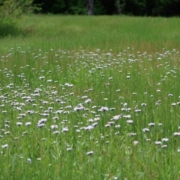

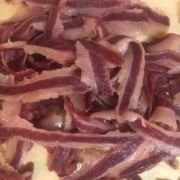
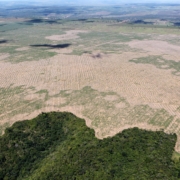
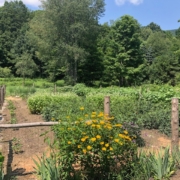
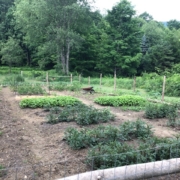
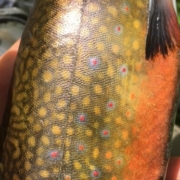
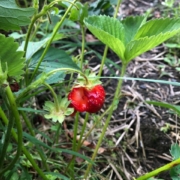
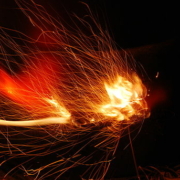 MarcusObal, Wikimedia
MarcusObal, Wikimedia